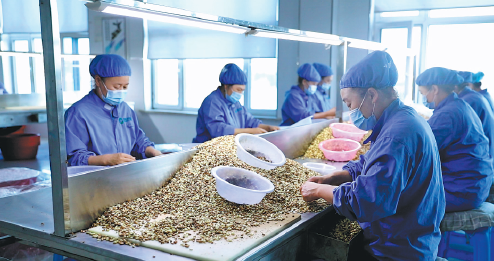Consumers worldwide go 'nuts' for Jilin product
As Northeast China welcomes the pine nut harvest season, workers at Fada Food Co in Meihekou, Jilin province, are busy processing the popular commodity in the factory.
In the company's drying facility, employees spread out pine cones, filling the air with a rich fragrance.
After being dried, the pine cones will be processed into pine nuts and sold to countries and regions in Asia, Europe and North America.
"Since late August, our employees have been going to the provinces of Liaoning, Jilin and Heilongjiang to purchase pine cones," said Xie Yu, the company's general manager.
"The pine cone harvest is in autumn, and we plan to purchase 500 metric tons of red pine cones. Meanwhile, we have received a large amount of orders, ushering in a peak season for pine nuts," she added.
Established in 2013, the company is engaged in deep processing and export of pine nuts, achieving an import and export volume of 67 million yuan ($9.25 million) in 2023.
As the world's largest pine nut distribution center, each year, Meihekou gathers pine nut raw materials from around the world, where they are dried, processed and then sold to over 40 countries and regions worldwide.
"There are 303 pine nut processing enterprises in Meihekou, producing about 50,000 tons of nut products annually, accounting for around 80 percent of the national output," said Cui Lin, deputy secretary-general of the city's pine nut association.
"Among them, nearly 10,000 tons of finished nut products are exported, firmly holding over 60 percent of the global pine nut market share. It is estimated that around 80,000 tons of pine nut raw materials will be processed in Meihekou this year and then sold to various parts of the world," Cui said.
As one of the oldest plants on Earth, pine trees have existed for about 300 million years and the history of pine nuts being consumed in China can be traced back over 2,000 years.
Since the late 1970s and early 1980s, when people in Meihekou learned about demand for pine nut products abroad, they immediately began to establish business channels.
As the local soil was not suitable for pine trees, they started purchasing pine cones from the Changbai Mountain area, processing them by shelling and drying, and exporting them as pine nuts.
In the late 1990s, the use of pine nut processing machinery greatly increased production efficiency and more pine nut processing enterprises appeared in Meihekou, gradually making it a base for pine nut processing and trade as well as a hub for pine nut commercial information.
In recent years, with the continuous improvement of processing capabilities and the expansion of the trade market, pine nut procurement has expanded from Changbai Mountain to areas such as the Lesser Hinggan Mountains, the provinces of Yunnan, Shaanxi and Shanxi, as well as countries and regions including Russia, Mongolia, Pakistan and Kazakhstan.
Furthermore, the people of Meihekou have gradually found a way to accumulate wealth nearby by planting pine trees in the mountains surrounding Meihekou, making seed picking more convenient and cost-effective.
This autumn, Ding Yifeng, 32, has achieved a bountiful harvest in the red pine forests of Shuangxing township.
"It is my fourth year of contracting, and now the trees are around 40 to 50 years old. I'm likely to see a harvest of around 50 tons of pine cones this year, which may bring me good economic benefits," Ding said.
"The city has introduced a series of preferential policies, such as returning farmland to forests, and I believe in the future, more pine nuts will be harvested by ourselves," he added.
So far, Meihekou has cultivated and developed over 14,666 hectares of red pine forestland.
"In the future, we will focus on developing scientific and technological innovation of the products, increase the added value and extend the industrial chain," said Cui. "We hope to bring good enterprises, ideas and products to people around the world."
Contact the writers at zhouhuiying@chinadaily.com.cn















